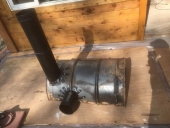My shop batch box dragon has always been a little finicky starting up when cold so I decided yesterday to install a bypass to see if it would help get the draft going a bit easier.
After a bunch of fiddling with different ideas, I settled on a blast gate design. Here is a typical picture of what they look like:
Pull the handle out to open, push in to close the hole. Easy-peasy.
 source
source
I didn't want to wait for many weeks to get one in the mail so I decided to fabricate one using an old microwave casing for the metal and securing it together with a pop rivet gun.
This 4" bypass hole is about 20" above the existing chimney entrance just above floor level of my bench bell.
So far the slider works great and feels solid, providing a really good seal.
The two burns I've used it have made starting easier.
My shop dragon has two double stacked barrels so it does still take a minute or so to build up enough hot gasses to get a draft really going even with the bypass open, but much simpler than the method I was using before - making a little fire under the exhaust entrance within the bench through a cleanout port.
Here are a few pictures showing my progress. I've since shortened the handle on the gate and made a 90 degree bend as a handle (just like in the above photo). All is now sealed up with cob also.








